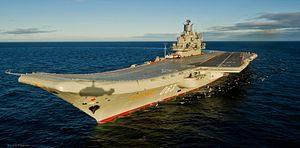The flight deck of the flagship of the Russian Navy, the aircraft carrier Admiral Kuznetsov, will undergo a major upgrade to carry MiG-29K/MiG-29KUB fighter jets as part of a general overhaul of the warship slated to begin in the coming weeks, according to Russian defense industry officials.
“MiG-29K/MiG-29KUB, Su-33 planes and some types of helicopters will be based on the warship,” the head of the Nevskoye Design Bureau, Sergei Orlov, said on August 6. “Some adjustments will be made precisely to accommodate MiG-29K/MiG-29KUB aircraft. Pilots want something new, something better and more reliable.”
The St. Petersburg-based Nevskoye Planning and Design Bureau is overseeing the entire modernization project of the aircraft carrier. The repair and modernization work is expected to take two and a half years, with the Admiral Kuznetsov slated to return to active duty in 2021. The carrier last underwent a smaller scale retrofit between 1996 and 1998.
A number of MiG-29K/MiG-29KUBs, the carrier-based naval version of the Mig-29M2 multi-role aircraft (the K variant is the single-seat model, KUB the two-seat version), were part of the Admiral Kuznetsov’s three-month deployment to the Mediterranean Sea, which began in October 2016, to support Russian combat operations in Syria.
The Syria mission laid bare various technical issues with the carrier and the aircraft. During the deployment, one MiG-29K/KUB multirole fighter crashed due to a faulty arresting wire while attempting an emergency landing shortly after takeoff. A Sukhoi Su-33 air superiority fighter plunged into the Mediterranean Sea when an arresting cable snapped during the landing.
Arresting cables or wires are used to rapidly decelerate and stop an aircraft when it lands on the deck of an aircraft carrier at sea.
As a result of the accident, the Russian Navy’s entire Mig-29K/JUB fleet was grounded for a number of months pending an investigation into the accidents. The technical problems that caused the loss of the two aircraft are expected to be fixed during modernization work.In 2012 the Russian Navy ordered 20 Mig-29K and four Mig-29KUB to replace the aging Su-33 air superiority fighter as the Admiral Kuznetsov’s air wing.
The Russian carrier uses a so-called ski-jump assisted Short Take-Off But Arrested Recovery (STOBAR) launch systems, which puts severe limits on the operational range and armament of Mig-29K/KUB and Su-33s launched from the Admiral Kuznetsov, and also wears the aircraft out faster as the launching method puts severe strain on the fighter jets’ airframes.
A contract between the Russian Ministry of Defense and United Shipbuilding Corporation (USC) for the modernization and repair of the Admiral Kuznetsov was signed in June. The conclusion of the agreement was preceded by a contractual disputes between the two sides as USC insisted that the work on the carrier could not be finished under four years.
As I reported last week, the carrier is expected to conduct seven months of acceptance trials following the successful completion of the warship’s modernization in 2021. However, delays in the overhaul of the carrier can be expected.































